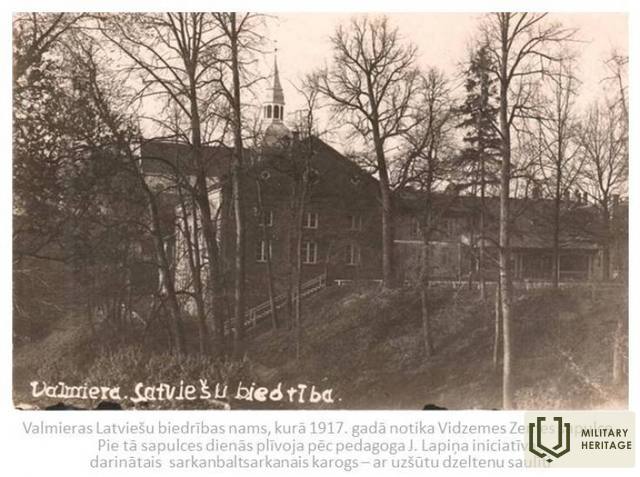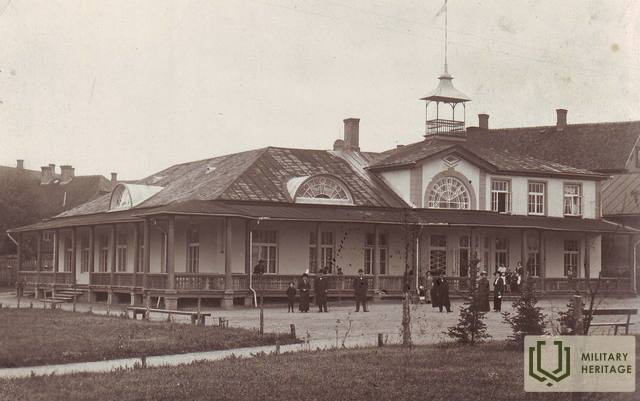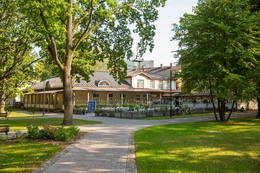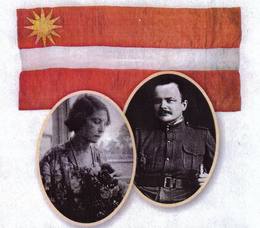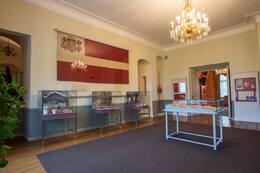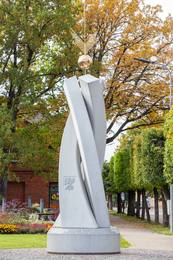1917 m. kovas – svarbus mėnuo Valmieros ir Latvijos istorijoje
1917 metų kovą, likus daugiau nei metams iki Latvijos valstybės paskelbimo, Valmieroje buvo įkurta Vidžemės laikinoji žemės taryba, kuri priėmė nutarimą dėl Latvijos autonomijos ir apsisprendimo teisių. Tarybos įkūrimo dieną posėdžio vietoje pirmą kartą buvo iškelta raudona, balta ir raudona vėliava.
1917 m. kovo 12 ir 13 dienomis (kovo 25, 26 d.) įvyko Vidžemės žemės suvažiavimas. Į Valmierą susirinko savivaldybių, kooperatinių asociacijų, žemės ūkio bendrijų atstovai ir bežemiai iš Rygos, Cėsių, Valmieros ir Valkos apskričių. Nors darbotvarkėje buvo ir politiniai, ir ekonominiai klausimai, tikrasis susirinkimo uždavinys buvo įkurti Vidžemės laikinąją žemės tarybą. Pagrindinis pranešėjas agronomas Kārlis Ulmanis akcentavo politinius tikslus, kurių reikia siekti ateityje. Priimta 17 nutarimų, iš kurių svarbiausia – dėl Latvijos autonomijos ir apsisprendimo teisės.
Nepraėjus nė dvejiems metams, 1918-ųjų lapkričio 17-osios vakarą Rygos viešbutyje „Suvorov“ buvo suformuota Latvijos liaudies taryba, kurioje buvo išrinktas Latvijos laikinosios vyriausybės ministras pirmininkas Kārlis Ulmanis. Liaudies taryba nusprendė Latvijos valstybės paskelbimo aktą atlikti Latvijos operos teatre (dabar Latvijos nacionalinis teatras).
Jau kitą dieną, 1918 m. lapkričio 18 d., Valmieroje daktaras Georgas Apinis paprašė vokiečių okupacinės valdžios leidimo surengti Valmieros sporto draugijos visuotinį susirinkimą Vecpuiši parko paviljono salėje. Tikruosius jo ketinimus žinoję G. Apinio bendražygiai slapta pagamino raudonai-baltai raudoną vėliavą ir atgamino tekstus „Dieve, palaimink Latviją“ ir pristatė juos į Senelių parko paviljono salę. Dr. G. Apinis susirinkusiuosius informavo apie šios dienos istorinę reikšmę, o susirinkusieji iškilmingai įsipareigojo paremti naująją valstybę ir jos Laikinąją vyriausybę, vadovaujamą Kārlio Ulmanio. Šią dieną Valmieroje pirmą kartą buvo pakelta valstybės vėliava ir pirmą kartą nuskambėjo naujasis himnas „Dieve, palaimink Latviją“.
Įdomu tai, kad valmieriečiai vieni pirmųjų sužinojo, kad buvo įkurta Latvijos valstybė. Užvakar tai buvo žinoma ir Valmieros realinėje mokykloje, ką liudija 1918-11-18 įrašas mokinio dienoraštyje – „Dėl Latvijos valstybės paskelbimo paskutinės trys pamokos nevyks“. Lapkričio 18 dieną priešais mokyklą su raudonais, baltais ir raudonais kaspinais nusifotografavo ir Valmieros vidurinės mokyklos mokiniai.
Šaltinis: Valmieros muziejaus istorijos skyrius
Susijusi laiko juosta
Susijusios temos
Susijusios vietos
Bachelor Park and Concert Hall "Valmiera"
The park is located in the center of Valmiera.
In 1914, eight enterprising residents of Valmiera decided to set up a park with a non-alcoholic buffet and a book table on the outskirts of the city at that time - that's how the history of the Bachelor Park began.
The construction of the park was interrupted by the First World War.
Already at the beginning of the war, a hospital for wounded soldiers was set up in the hall of the pavilion. On the second floor of the building was the Valmiera Red Cross Committee, its central gift reception point and warehouse.
The Valmiera committee was one of the busiest in Latvia. In October 1914, it had 33 infirmaries with 375 beds under its care. The committee collected funds for the maintenance of infirmaries and the treatment of wounded soldiers, for supplying the cured with warm clothes and travel money, for feeding wounded soldiers passing through, and also sent gifts directly to the front. One of the most active employees of the Red Cross Committee in collecting funds was the later first Prime Minister of independent Latvia, Kārlis Ulmanis (1877-1942).
The history of the founding of the legendary Latvian rifle battalions is also connected with the Vecpuišu Park. On August 4 and 5, 1915, the commission for accepting volunteers worked in the park premises, and on August 6, the young soldiers were taken out for training. Also later, the boys of Valmiera and the surrounding area were taken out of here many times in military marches. Various cultural and charity events were also held in the park during the war, however, all the funds obtained from them were used to help the victims of the war.
On November 18, 1918, the national flag was raised as the state flag for the first time in Valmiera and the anthem of the new country "God bless Latvia" was played for the first time.
During the Second World War, there was an infirmary in the pavilion building of the Bachelor Park and archers were taken to the battles. During the Soviet occupation, on August 12, 1940, by the decision of the Valmiera city board, the park was renamed Komjaunatnes park.
After the Second World War, the pavilion built by architect Freiberg was used both as a cultural center (until 1966) and as a sports school. At the end of the nineties (1998) the Vecpišu Park pavilion started to get busy again.
The founders of the park can be seen in the photos placed in the premises of the "Vecpuisis" restaurant.
Memorial place of J. Lapiņš, the author of the first flag of Latvia
It is located in "Lejas Pintuli", Veselava parish, Priekuļi district.
A memorial to Jānis Lapiņas, the author of the pre-flag of Latvia, can be seen.
The Latvian national flag was created during the First World War. In 1915, when creating the flags of the Latvian rifle battalions, some artists offered red and white colors to the flag throwers. In the second half of 1916, the red-and-white flag thrown by the pedagogue and journalist Jānis Lapiņa was made by his student, Marianna Straumane, a teacher at the refugee shelter in Valmiera.
It is the first known and actually made Latvian national flag, which has survived to our days.
In 2014, a memorial to Jānis Lapiņas, the author of the pre-flag, was opened in "Lejas Pintuulis" of Veselava Parish, Priekuļi County.
The first known authentic Latvian national flag, which passed through the refugee corridors in Russia, was carefully hidden during the Soviet and German occupation, and is currently kept in the Cēsis Museum of History and Art . It was given as a gift in 1997 by their daughter Lija Poga.
Cēsis history and art museum in the New Castle of Cēsis
The Cēsis History and Art Museum is located in the very centre of the Old Town of Cēsis, in the New Castle. The museum holds a permanent exhibit of history and interiors named ‘Cēsis, a Symbol of Latvian History’, with two thematic sections: the exhibit ‘Red-White-Red Flag in the History of Cēsis and Latvia’ explains the history of the Latvian national flag from the 13th to 20th centuries, the approved national symbol, the flags of Latvian rifle battalions and the traditions of using national colours during the Latvian War of Independence. The exhibit ‘Cēsis and the Latvian War of Independence’ focuses on the founding of the Cēsis Company in December 1918, the joint battle efforts of Estonians and Latvians in the 1919 Battles of Cēsis, the time when, during the Bermondt Affair, Cēsis served as the temporary capital of Latvia for a short time, as well as the history of the Cēsis Victory Monument. In an escape room named ‘Legends of the Battles of Cēsis’, the participants have one hour to find their way out by solving puzzles, making connections and finding hidden objects. The Cēsis Company, one of the first units of the Latvian Armed Forces, was established on 8 December 1918 in Cēsis Castle by Senior Lieutenant Artūrs Jansons. The museum’s exhibit features a memorial plaque dedicated to the Cēsis Company, unveiled on 8 December 1933 at the Cēsis New Castle, which, at the time, served as the headquarters of the 8th Daugavpils Infantry Regiment and the garrison officers’ club.
Monument "Dedication to the Latvian Provisional National Council"
The monument “Dedication to the Latvian Provisional National Council” is located at the intersection of Rīgas and Raina streets in Valka (address 9A Raina Street).
The monument was unveiled on December 2, 2017 within the framework of the Latvian Centennial Program, in honor of the meeting of the Latvian Provisional National Council in 1917.
The author of the idea of the ensemble is the sculptor Arta Dumpe, the stonemason - Ivars Feldbergs, the architectural planning was performed by SIA "Arhitektu birojs Vecumnieks & Bērziņi".
The base of the monument is formed by a large millstone - as a circle of life, time and events. The names of the members of the LPNP board are engraved on the side. Three counties with their historical coats of arms wind from the millstone as roads of destiny in the sky. Vidzeme, Kurzeme and Latgale. The composition concludes with the star of Bethlehem, which transforms into the sun of the new Latvian state. The Latvian poet, prose writer and politician Kārlis Skalbe / 1879-1945 / has written: "Latvia has also had its own Bethlehem, the little poor Valka ...".
The monument to the Latvian Provisional National Council is the return of a kind of debt to the people who, in 1917, risking their lives in Valka, laid the foundations for the Latvian state in an ideally managed, virtually impossible situation.
At that time, Valka was the city with the largest population of Latvians in the unoccupied territory of Germany. After the fall of Riga, it became the center of Latvian social, political and cultural life. Those who were united by the desire to exercise the right of self-determination of the Latvian nation gathered here. From November 29 to December 2, 1917 (according to the new style) the 1st session of the Latvian Provisional National Council took place in Valka City Hall (now the building in Valga Kesk Street No. 11), which was attended by representatives of almost all the most influential Latvian public organizations and political parties. . For the first time, they officially declared the goal of their activity - the establishment of an independent national state, adopted a declaration on the establishment of a united and autonomous Latvia in the Latvian districts of Vidzeme, Kurzeme and Latgale.




